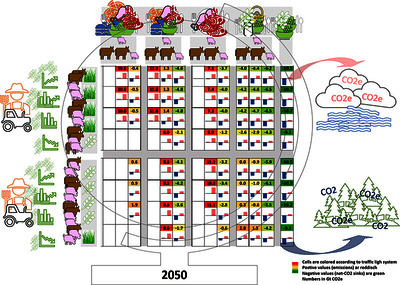Theurl, M.C., Lauk, C., Kalt, G., Mayer, A., Kaltenegger, K.  ORCID: https://orcid.org/0000-0001-7751-7794, Morais, T.G., Teixira, R.F.M., Domingos, T., et al.
(2020).
Food systems in a zero-deforestation world: Dietary change is more important than intensification for climate targets in 2050.
Science of the Total Environment 735 e139353. 10.1016/j.scitotenv.2020.139353.
ORCID: https://orcid.org/0000-0001-7751-7794, Morais, T.G., Teixira, R.F.M., Domingos, T., et al.
(2020).
Food systems in a zero-deforestation world: Dietary change is more important than intensification for climate targets in 2050.
Science of the Total Environment 735 e139353. 10.1016/j.scitotenv.2020.139353.
Preview |
Text
1-s2.0-S0048969720328709-main.pdf - Accepted Version Available under License Creative Commons Attribution No Derivatives. Download (2MB) | Preview |
![[thumbnail of 1-s2.0-S0048969720328709-ga1_lrg.jpg]](https://pure.iiasa.ac.at/16475/2.hassmallThumbnailVersion/1-s2.0-S0048969720328709-ga1_lrg.jpg)  Preview |
Image
1-s2.0-S0048969720328709-ga1_lrg.jpg - Graphical Abstract Available under License Creative Commons Attribution Non-commercial No Derivatives. Download (212kB) | Preview |
Abstract
Global food systems contribute to climate change, the transgression of planetary boundaries and deforestation. An improved understanding of the environmental impacts of different food system futures is crucial for forging strategies to sustainably nourish a growing world population. We here quantify the greenhouse gas (GHG) emissions of global food system scenarios within a biophysically feasible “option space” in 2050 comprising all scenarios in which biomass supply – calculated as function of agricultural area and yields – is sufficient to cover biomass demand – derived from human diets and the feed demand of livestock. We assessed the biophysical feasibility of 520 scenarios in a hypothetical no-deforestation world.
For all feasible scenarios, we calculate (in) direct GHG emissions related to agriculture. We also include (possibly negative) GHG emissions from land-use change, including changes in soil organic carbon (SOC) and carbon sinks from vegetation regrowth on land spared from food production. We identify 313 of 520 scenarios as feasible. Agricultural GHG emissions (excluding land use change) of feasible scenarios range from 1.7 to 12.5 Gt CO2e yr−1. When including changes in SOC and vegetation regrowth on spare land, the range is between −10.7 and 12.5 Gt CO2e yr−1. Our results show that diets are the main determinant of GHG emissions, with highest GHG emissions found for scenarios including high meat demand, especially if focused on ruminant meat and milk, and lowest emissions for scenarios with vegan diets. Contrary to frequent claims, our results indicate that diets and the composition and quantity of livestock feed, not crop yields, are the strongest determinants of GHG emissions from food-systems when existing forests are to be protected.
| Item Type: | Article |
|---|---|
| Uncontrolled Keywords: | Food systems;GHG emissions;diets;feed consumption;climate targets;carbon sinks |
| Research Programs: | Air Quality & Greenhouse Gases (AIR) |
| Depositing User: | Luke Kirwan |
| Date Deposited: | 18 May 2020 05:55 |
| Last Modified: | 27 Aug 2021 17:33 |
| URI: | https://pure.iiasa.ac.at/16475 |
Actions (login required)
 |
View Item |
 Tools
Tools Tools
Tools